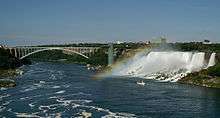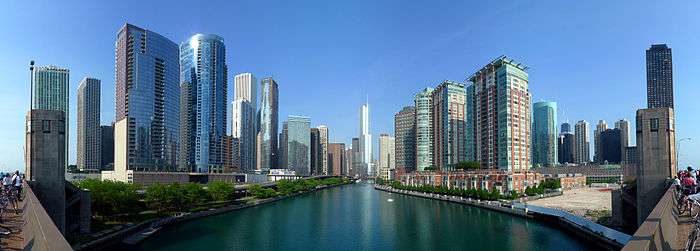Continental climate

Continental climates are climates with significant annual variation in temperature. They tend to occur in the middles of continents, where prevailing winds come from over land, and temperatures are not moderated by bodies of water such as oceans or seas. They mostly occur in the eastern U.S. and mainland China,[1] and at higher elevations in other parts of the world.
Often winter temperatures are cold enough to support a fixed period of snow each year. Precipitation tends to be moderate, occurring mostly in summer, although there are exceptions such as the upper east coast areas of North America which show an even distribution of precipitation: these are called humid continental climates. Only a few areas, in the mountains of the Pacific Northwest of North America and in Iran, northern Iraq, adjacent Turkey, Afghanistan, Pakistan, and Central Asia show a winter maximum in precipitation.
Spring and autumn
The timing of intermediate spring-like or autumn-like temperatures in this zone vary depending on latitude and/or elevation. For example, spring may arrive as soon as early March in the southern parts of this zone, or as late as May in the north. Annual precipitation in this zone is usually between 600 millimetres (24 in) and 1,200 millimetres (47 in), most of it in the form of snow during winter. It also has cold winters and warm summers.
Köppen climate classification
Most such areas fit Köppen classifications of Dfa, Dwa (cold winters, hot summers; "w" indicating very dry winters characteristic especially of China) or Dfb or Dwb (cold winters, warm summers, same distinction for winter dryness). Dry summer continental climates (Dsa and Dsb) exist in high altitude areas near Mediterranean climates. In some cases, the semi-arid climate classification of BSk can also be considered to be continental as long it has cold winter. The definition of this climate regarding temperature is as follows: the mean temperature of the coldest month must be below −3 °C (26.6 °F) and there must be at least four months whose mean temperatures are at or above 10 °C (50 °F). Some climatologists use the 0 °C isotherm instead for the coldest month.
Climatology
Continental climates exist where cold air masses infiltrate during the winter and warm air masses form in summer under conditions of high sun and long days. Places with continental climates are as a rule either far from any moderating effects of oceans (examples: Omaha, Nebraska and Kazan, Russia) or are so situated that prevailing winds tend to head offshore (example: New York City, USA). Such regions get quite warm in the summer, achieving temperatures characteristic of tropical climates but are much colder than any other climates of similar latitude in the winter.
Neighboring climates
These climates grade off toward subtropical climates equator-ward where winters are less severe and semiarid climates where precipitation becomes inadequate for tall-grass prairies. In Europe these climates may grade off into oceanic climates in which the influence of moderating air masses is more marked toward the west. The subarctic climate (Köppen: Dfc), with very cold, long and dry winters, but with at least one month above 10 °C (50 °F), might be considered a sub-type of the continental climate.
List of locations with a continental climate
North America

- Canada: Throughout much of southern Canada from the Rocky Mountains to Atlantic Canada. Major cities: Whistler, Prince George, Kamloops, Calgary, Edmonton, Fort McMurray, Saskatoon, Regina, Winnipeg, Kenora, Thunder Bay, Sault Ste. Marie, Greater Sudbury, North Bay, Ontario, Timmins, Sarnia, London, Ontario, Kitchener, Ontario, Toronto, Niagara Falls, Kingston, Ottawa, Val-d'Or, Montreal, Sherbrooke, Quebec City, Saguenay, Sept-Îles, Fredericton, New Brunswick, Moncton, New Brunswick, Halifax, Sydney, Nova Scotia, Charlottetown, Prince Edward Island, St. John's
- United States: Throughout much of northern US, including parts of Alaska, and farther south at high elevations in Oregon, California, and Arizona, and along the Appalachian Mountains: Major cities: Spokane, South Lake Tahoe, Bridgeport, Carson City, Flagstaff, Idaho Falls, Wallace, Billings, Cheyenne, Salt Lake City, Aspen, Denver, Fargo, Sioux Falls, Omaha, Kansas City, Des Moines, Minneapolis, Green Bay, Milwaukee, St. Louis, Chicago, Indianapolis, Detroit, Cincinnati, Lexington, Columbus, Cleveland, Youngstown, Pittsburgh, Erie, Scranton, Wheeling, Charleston, West Virginia, Oakland, Maryland, Boone, North Carolina, Buffalo, Rochester, Syracuse, Albany, New York City (which borders a humid subtropical climate), Montpelier, Concord, Hartford, Providence, Worcester, Boston, Portland, Maine, Augusta, Maine, Juneau, Alaska
-

A statue of Ilanaaq, mascot of the 2010 Olympics, located on Whistler Mountain
-

North Saskatchewan River valley in Edmonton
-

The Forks, with St. Boniface Cathedral in the background in Winnipeg
-

Toronto skyline taken from Colonel Samuel Smith Park in Etobicoke.
-

Rainbow Bridge and the American Falls in Niagara Falls
-

Ice skaters on the frozen Rideau Canal, looking south from Laurier Avenue Bridge in Ottawa
-

Olympic Stadium in Montreal
-
Québec City shore
-

Halifax as seen from the Dartmouth waterfront
-

Duckworth Street in St. Johns
-

The Chicago River, with the Near North Side and Streeterville on the right, the Chicago Loop, Lakeshore East, and Illinois Center on the left, and Trump Tower at the jog in the river in the center. This view is looking west from Lake Shore Drive's Outer Drive Bridge.
-

Times Square in Manhattan, New York City
-

Boone as seen from Howard's Knob
-
Mixed forest in Vermont during autumn
-

Boston's skyline in the background, with fall foliage in the foreground
-

San Francisco Peaks from Flagstaff
South America
- Argentina: Puente del Inca, Mendoza Province
- Chile: Balmaceda
Europe


- United Kingdom: In some areas with high elevations in Scotland: Major cities: Braemar, Altnaharra, Dalwhinnie, Leadhills
- France: Chamonix
- Belgium: Bertrix
- Italy: Bruneck, Cortina d'Ampezzo
- Austria: Vienna (bordering an oceanic climate and a humid subtropical climate), Innsbruck, Salzburg (bordering an oceanic climate)
- Switzerland: Zürich (bordering an oceanic climate), Lausanne, Bern
- Germany: Berlin (bordering an oceanic climate), Munich, Garmisch-Partenkirchen
- Denmark: Copenhagen (bordering an oceanic climate)
- Norway: Oslo, Trondheim, Lillehammer
- Sweden: Stockholm, Gothenburg
- Finland: Helsinki, Turku
- Estonia: Tallinn
- Latvia: Riga
- Lithuania: Vilnius
- Belarus: Minsk, Grodno
- Ukraine: Kiev, Kharkiv, Lviv
- Czech Republic: Prague
- Poland: Warsaw, Wrocław, Szczecin
- Slovakia: Bratislava
- Hungary: Budapest (bordering an oceanic climate or humid subtropical climate}
- Bulgaria: Sofia, Pleven
- Croatia: Zagreb
- Romania: Bucharest
- Bosnia and Herzegovina: Sarajevo, Banja Luka (bordering a humid subtropical climate)
- Bulgaria: Sofia
- Moldova: Chișinău
- Serbia: Belgrade
- Russia: throughout much of southern Russia except coastal Black Sea. Major cities: Moscow, Saint Petersburg, Kazan, Novosibirsk, Ulan-Ude, Abakan ,Vladivostok
Africa

- Morocco: Oukaimeden, Khenifra, Imilchil, and Azilal
Middle East
- Turkey: Hakkâri, Muş, Erzurum, Ardahan, Sivas, Yüksekova, Van, Kayseri, Bolu
- Iran: Sanandaj, Saqqez, Arak, Ardabil, Tabriz
Asia

- Georgia: Gori
- Armenia: Yerevan, Gyumri
- Azerbaijan: Nakhchivan
- Kazakhstan: Astana, Almaty, Oskemen, Oral
- Kyrgyzstan: Bishkek, Naryn
- Afghanistan: Kabul
- Uzbekistan: Nukus, Andijan
- Pakistan: Skardu
- India: Leh, Dras
- Mongolia: Ulaanbaatar, Ulaangom
- China: Ürümqi, Turpan, Shijiazhuang, Lhasa, Beijing, Harbin, Tianjin, Changchun, Heihe, Qiqihar, Xining
- North Korea: Pyongyang, Nampo
- South Korea: Seoul, Pyeongchang County
- Japan: Mostly found in the Hokkaido region as well as high elevations in Mainland Japan: Major cities: Sapporo, Kushiro, Asahikawa, Nayoro, Aomori
Oceania

- Australia: High elevations such as the Victorian Alps between Victoria and New South Wales and in Tasmania: Major cities: Collinsvale, Mount Buller (bordering a subartic climate), Kiandra, Cabramurra, Charlotte Pass (bordering a subartic climate)
See also
References
- ↑ "Continental Climate". Encyclopedia of the Atmospheric Environment. Manchester Metropolitan University. Archived from the original on 2009-04-27.
External links
| Wikimedia Commons has media related to Continental climate. |
